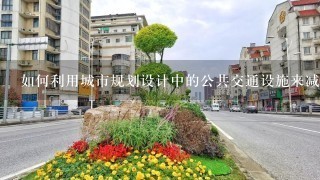如何利用城市规划设计中的公共交通设施来减少交通拥堵?

Answer:
1. Pedestrian-Friendly Infrastructure:
- Create dedicated bike lanes, pedestrian walkways, and safe areas for cyclists.
- Install traffic signals that prioritize pedestrians and cyclists.
- Design intersections to be more pedestrian-friendly, with reduced speed limits and traffic signals.
2. Public Transportation Enhancements:
- Improve bus frequency, reliability, and frequency.
- Expand bus stops and shelters to make them more accessible.
- Offer real-time tracking information for buses and trains.
3. Multi-Modal Connectivity:
- Create multimodal hubs where people can transfer between different modes of transportation, such as bus stops, train stations, and bike racks.
- Encourage walking and cycling to connect different destinations.
4. Traffic Management Measures:
- Implement congestion pricing or tolls during peak hours.
- Use intelligent traffic management systems to optimize traffic flow.
- Encourage carpooling and ridesharing programs.
5. Public Awareness and Education:
- Raise awareness about the benefits of public transportation and walking/cycling.
- Provide information and resources to help people plan their trips more efficiently.
6. Green Infrastructure:
- Incorporate green spaces and vegetation into the urban landscape.
- Use green roofs and walls to absorb pollutants and improve air quality.
7. Flexible and Adaptable Design:
- Design public transportation facilities to be easily expanded or modified as needed.
- Allow for future growth and changes in traffic patterns.
8. Collaboration and Partnerships:
- Foster collaboration between city officials, businesses, and community groups to implement sustainable transportation solutions.
- Share best practices and lessons learned from other cities.





































































